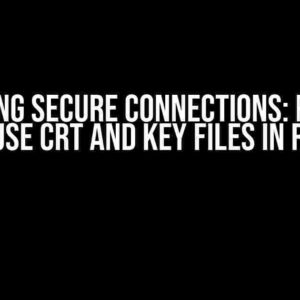Are you tired of dealing with the frustrating “dead loop” issue in your custom delay function while working with Keil C51 and the STC89C52RC microcontroller? You’re not alone! This common problem can be a major obstacle in your project, but fear not, dear developer, for we’ve got you covered. In this in-depth guide, we’ll take you by the hand and walk you through the process of identifying and resolving this pesky issue once and for all.
What is a Dead Loop?
A dead loop, also known as an infinite loop, is a sequence of instructions that continues to execute indefinitely, causing your program to hang or freeze. In the context of a custom delay function, this means that the delay loop never terminates, resulting in a system crash or malfunction.
Causes of Dead Loops in Custom Delay Functions
Before we dive into the solution, let’s take a look at some common causes of dead loops in custom delay functions:
-
Incorrectly implemented loop counters
-
Misconfigured timer settings
-
Inadequate use of bit manipulation techniques
-
Poorly written or optimized code
Understanding the STC89C52RC Microcontroller
The STC89C52RC is a popular 8-bit microcontroller from STC Micro, widely used in various applications such as robotics, IoT, and automation. It’s essential to understand the architecture and features of this microcontroller to effectively troubleshoot and resolve the dead loop issue:
| Feature | Description |
|---|---|
| Processor Core | 8-bit 8051 microprocessor core |
| Memory | 8KB flash, 256B RAM, 1KB EEPROM |
| Timers | Two 16-bit timers (T0 and T1) |
| UART | Synchronous and asynchronous communication modes |
Debugging and Troubleshooting
To identify the root cause of the dead loop issue, follow these steps:
-
Review your code: Carefully examine your custom delay function, paying attention to loop counters, timer settings, and bit manipulation techniques.
-
Use a debugger: Utilize Keil µVision’s built-in debugger to step through your code, inspecting variables and registers.
-
Verify timer settings: Ensure that your timer settings are correct, and the timer is not overflowing or stuck in a perpetual loop.
-
Analyze the disassembly: Inspect the disassembled code to identify any issues with instruction sequencing or memory access.
Resolving the Dead Loop Issue
Now that we’ve identified the potential causes and troubleshooting steps, let’s dive into the solution:
Example Code: Custom Delay Function using Timer 0
#include <reg51.h>
void delay_ms(unsigned int time)
{
unsigned int i, j;
TMOD = 0x01; // Timer 0 in mode 1 (16-bit timer)
TH0 = 0x3C; // Load timer 0 with the correct value
TL0 = 0x00;
for (i = 0; i < time; i++)
{
TF0 = 0; // Clear timer 0 overflow flag
while (!TF0); // Wait for timer 0 overflow
}
}
Optimizations and Best Practices
To avoid dead loops in your custom delay function, follow these best practices:
-
Use a volatile variable to ensure the compiler doesn’t optimize away the delay loop.
-
Implement a timeout mechanism to prevent the delay function from running indefinitely.
-
Use bit manipulation techniques to minimize code size and improve performance.
-
Verify your timer settings and ensure the timer is not overflowing or stuck in a perpetual loop.
Conclusion
In conclusion, the dead loop issue in custom delay functions can be a frustrating problem to deal with, but with the right approach and troubleshooting techniques, it can be easily identified and resolved. By understanding the STC89C52RC microcontroller, following best practices, and implementing optimizations, you’ll be well on your way to creating reliable and efficient custom delay functions with Keil C51.
Remember, debugging and troubleshooting are essential skills for any embedded systems developer. With practice and patience, you’ll master the art of debugging and become proficient in resolving even the most complex issues.
Frequently Asked Questions
Q: What is the maximum delay time achievable with the STC89C52RC’s Timer 0?
A: The maximum delay time achievable with Timer 0 depends on the crystal frequency and timer mode. In mode 1 (16-bit timer), the maximum delay time is approximately 65.5 milliseconds with a 12 MHz crystal frequency.
Q: Can I use Timer 1 instead of Timer 0 for my custom delay function?
A: Yes, you can use Timer 1 instead of Timer 0. However, keep in mind that Timer 1 has different settings and may require adjustments to your code.
Q: How do I optimize my custom delay function for low power consumption?
A: To optimize your custom delay function for low power consumption, use techniques such as reducing the clock frequency, disabling unnecessary peripherals, and using power-saving modes.
Frequently Asked Question
Get ready to debug your way to success with our top 5 FAQs about Keil C51’s dead loop in custom delay function for STC89C52RC!
Q1: What is the purpose of a delay function in Keil C51, and how does it relate to the STC89C52RC microcontroller?
A delay function in Keil C51 is used to introduce a wait state in the program, allowing for synchronization with external events or hardware components. In the case of the STC89C52RC microcontroller, the delay function is essential for tasks like button debouncing, serial communication, and timer initialization.
Q2: What causes a dead loop in a custom delay function, and how can I identify it in my Keil C51 code?
A dead loop occurs when a delay function becomes stuck in an infinite loop, causing the program to hang or freeze. This can be due to incorrect loop counter initializations, faulty conditional statements, or incomplete loop termination conditions. To identify a dead loop, look for symptoms like program freezing, LED lights staying on indefinitely, or the microcontroller becoming unresponsive.
Q3: How can I implement a custom delay function in Keil C51 for the STC89C52RC microcontroller, and what are some best practices to avoid dead loops?
To create a custom delay function, use a timer or a software-based delay loop. For a timer-based delay, utilize the STC89C52RC’s built-in timers and configure them according to the desired delay period. For a software-based delay, use a loop counter and a conditional statement to control the delay duration. Best practices include using a reliable timer source, avoiding signed integer overflows, and ensuring proper loop termination conditions.
Q4: What are some common pitfalls to avoid when writing a custom delay function in Keil C51, and how can I debug them?
Common pitfalls include incorrect timer configurations, inaccurate delay calculations, and incomplete loop termination conditions. To debug these issues, use Keil C51’s built-in debugger to step through your code, examine register values, and monitor program execution. Utilize breakpoints, watch windows, and the logic analyzer to identify and rectify the problems.
Q5: How can I optimize my custom delay function in Keil C51 for the STC89C52RC microcontroller to achieve the best performance and efficiency?
To optimize your delay function, consider using a timer-based delay with a high-precision timer source, like the STC89C52RC’s Timer 0 or Timer 1. Minimize software-based delay loops, as they can consume more CPU cycles and reduce system performance. Additionally, implement delay functions using inline assembly code or optimized C code to reduce overhead and improve execution speed.




